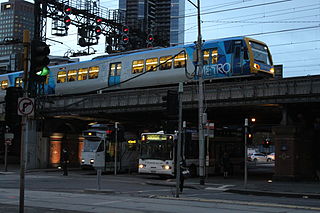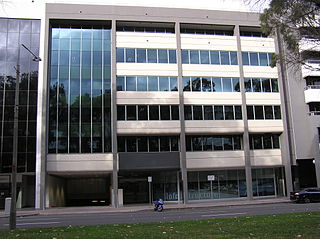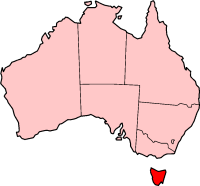
The Capricorn Highway is located in Central Queensland, Australia, and links the city of Rockhampton with western Queensland. The highway is 575 kilometres (357 mi) long, and joins the Landsborough Highway at Barcaldine. Formerly National Route 66, Queensland began to convert to the alphanumeric system much of Australia had adopted in the early-2000s and is now designated as A4. The highway runs parallel with the Tropic of Capricorn, hence its name.

The Ministry of Land, Infrastructure, Transport and Tourism, abbreviated MLIT, is a ministry of the Japanese government. It is responsible for one-third of all the laws and orders in Japan, and is the largest Japanese ministry in terms of employees, as well as the second-largest executive agency of the Japanese government after the Ministry of Defense. The ministry oversees four external agencies including the Japan Coast Guard, the Japan Meteorological Agency and the Japan Tourism Agency.

Transport in Melbourne, the state capital of Victoria, Australia, consists of several interlinking modes. Melbourne is a hub for intercity, intracity and regional travel. Road-based transport accounts for most trips across many parts of the city, facilitated by Australia's largest freeway network. Public transport, including the world's largest tram network, trains and buses, also forms a key part of the transport system. Other dominant modes include walking, cycling and commercial-passenger vehicle services such as taxis.

The Department of Infrastructure, Transport, Regional Development and Cities was an Australian Public Service department of the Government of Australia that existed between December 2017 and May 2019, charged with the responsibility for infrastructure and major projects, transport, local government, external territories administration, rural and regional development, population policy, and cities.

The Mines and Geo-sciences Bureau (MGB) is a government agency of the Philippines under the Department of Environment and Natural Resources (DENR). The MGB is responsible for the conservation, management, development and use of the country's mineral resources, including those in reservations and public lands.
The Department of Infrastructure, Transport, Regional Development and Local Government was an Australian Government department that existed between December 2007 and September 2010. The Department was established following the change of government at the November 2007 federal election, when the previous Department of Transport and Regional Services gained a third outcome.
The Department for Infrastructure and Transport (DIT), formerly known as the Department of Planning, Transport and Infrastructure (DPTI), is a department of the Government of South Australia. The website was renamed as of 7 August 2020, but without a formal announcement of change of name or change in documentation about its governance or functionality.

Transport for NSW (TfNSW) is a New South Wales government transport and road agency established on 1 November 2011. The agency is a different entity to the New South Wales Department of Transport, a department of the New South Wales Government and the ultimate parent entity of Transport for NSW.

The Tasmanian Freight Equalisation Scheme is an Australian Government scheme to provide financial assistance to shippers of freight between Tasmania and mainland Australia. The scheme aims to assist in alleviating the sea freight cost disadvantage incurred by shippers of eligible non‐bulk goods moved between Tasmania and the mainland of Australia. It provides a freight subsidy to producers selling into Australian domestic markets, but not for exports outside of Australia.

The Department of Infrastructure and Transport was an Australian government department. It was formed in September 2010, following the federal election in August 2010. The department absorbing parts of the Department of Infrastructure, Transport, Regional Development and Local Government. Regional development and local government functions were sent to the Department of Regional Australia, Regional Development and Local Government. Following the 2013 federal election, the department was renamed on 18 September 2013 to become the Department of Infrastructure and Regional Development, regaining regional development and local government functions.

Western Sydney International Airport is a new international airport currently under construction within the suburb of Badgerys Creek, New South Wales, Australia.

The Department of Infrastructure and Regional Development was an Australian Government department that existed between September 2013 and December 2017. Matters dealt with by the department included: infrastructure planning and coordination; transport safety; land transport; civil aviation and airports; maritime transport including shipping; administration of Australian territories; constitutional development of the Northern Territory and the Australian Capital Territory; regional programs; regional development; local government matters; and regional policy.

Rail Projects Victoria (RPV) is an agency of the Government of Victoria, Australia, responsible for the management of certain major infrastructure projects on the Victorian rail network. Originally established as the Melbourne Metro Rail Authority (MMRA), to deliver the Melbourne Metro Rail Project, the office was later expanded in its responsibilities to include the management and planning of a number of major infrastructure programs on V/Line's regional rail services. It was renamed RPV in 2018 to reflect its expanded scope, and later became one of several project teams comprising the Department of Transport's Major Transport Infrastructure Authority.
The Department of Transport and Planning (DTP) is a government department in Victoria, Australia. Commencing operation on 1 January 2019 as the Department of Transport (DOT), the DOT was formed in machinery of government changes made by Premier Daniel Andrews after the re-election of his Labor government at the 2018 Victorian state election. The re-shuffle saw the "super-ministry" Department of Economic Development, Jobs, Transport and Resources abolished and its functions reassigned to the DOT and Department of Jobs, Precincts and Regions.
Western Sydney Infrastructure Plan (WSIP) is an A$4.1 billion 10-year road investment program in Western Sydney, New South Wales, jointly funded by the federal government and the New South Wales state government. Originally introduced in April 2014 as a $3.5 billion program consisting of key road upgrade projects in Western Sydney, particularly in the south west surrounding the future Western Sydney Airport, the program scope was later expanded and funding was increased to $4.1 billion. The funding is now split among:

The Department of Infrastructure, Transport, Cites and Regional Development was an Australian Public Service department of the Government of Australia that existed between May 2019 and January 2020, charged with the responsibility for infrastructure and major projects, transport, local government, external territories administration, rural and regional development, population policy, and cities.









